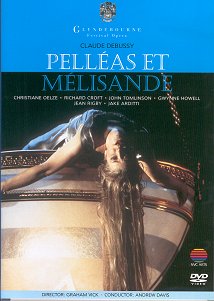Debussy's sole and inspired operatic masterpiece has done very well
on CD, and is showing signs of being equally lucky on DVD. My
benchmark is undoubtedly the 1992 Welsh National Opera production,
conducted by Pierre Boulez and directed with an astonishing blend
of naturalistic modernity yet total fidelity to the composer's
instructions by Peter Stein. It was released by DG a couple of
years ago and closely followed by another highly intelligent
staging from Lyons Opera, a very different offering conducted with
thought-provoking clarity by John Eliot Gardiner. Now we have the
1999 Glyndebourne version, a production which squarely divided the
critics but had a very successful run, followed by a long revival
tour in 2004.
I have tended to stand by the Stein/Boulez collaboration,
impressively transferred to DVD and sounding extremely fine. Graham
Vick's production for Glyndebourne could hardly be more different;
I can see why reviewers were divided and though the musical
qualities are never in doubt, the visual concept might not be to
everyone's taste.
Vick and his designer, Paul Brown, have chosen to set the action
not in some mythical past but basically around the time of the
opera's premiere. Thus we have a huge, cluttered Edwardian drawing
room, decked out with all manner of gilt-edged furniture and
pictureless hanging frames. Dominating everything is a vast, spiral
staircase which disappears up into the shadows and becomes the
focal point for much of the action. The clever perspex flooring
allows all manner of mirror effects and underfloor lighting tricks
to be played, including at one point the illumination of a sea of
coloured flowers.
Opting for one composite set, where the odd chair is shifted to
denote a scene change, rather than trying to give us Debussy's many
different locales, is Vick's biggest gamble. He has to play most of
the opera out as if it's all memory, rather as in the Lyon
production. So we don't see Golaud out lost in the dense forest
where he discovers Mélisande by a pool, as we do for WNO,
but instead the curtain goes up on John Tomlinson sat in a wing
armchair seemingly recounting events, finally 'discovering'
Mélisande curled naked under a blanket on the table.
Similarly, Golaud cannot lead Pelléas down into the castle's
dungeon vaults in blackness, so instead the two sit on the
staircase side by side and play the scene out there, albeit with a
lighting change. It's these restrictions that are my biggest
concern, though most of the ordinary interior scenes come off OK.
We certainly get a sense of Mélisande's claustrophobia, but
when Golaud admits that 'this castle is indeed cold and damp, vast
and dark' when we are actually in a comfortable, well-upholstered
room, there is a sense that some of Vick's anachronisms sit rather
uncomfortably. The worst offenders are two of the opera's most
famous moments, the 'hair' scene (Act 3, sc.1) and the insanely
jealous Golaud holding a frightened Yniold up to Mélisande's
window to spy on the couple. Or at least that's what's supposed to
happen. Here, Golaud has to do the opposite and hold Yniold down to
look through a hole in the floor. In the other scene, the 'Romeo
and Juliet'-style balcony magic is replaced by Mélisande
appearing from the inside of a giant suspended chandelier, rather
like a pantomime and much to the audible amusement of the audience.
There are moments like this throughout, but once you get inside
Vick's concept, you can see what he's aiming at. After all, this is
a psycho-drama, a memory opera, and the sight of this dysfunctional
family passing each other like ghosts in the night does get to the
emotional core of the work. But too many key moments, like those
above, have to go without the full symbolic weight that was
intended, and is indeed achieved in other productions.
On a musical front, things are much better. Indeed, I have to say
one cannot get much better singing or playing in this piece. John
Tomlinson may bark a bit too much in places, but he is in superb
voice and makes a frighteningly violent Golaud, more brutish than
WNO's Donald Maxwell but less subtle in places. Christine Oelze
oozes vulnerability and plays beautifully off the light-voiced
Pelléas of Richard Croft, who is uncannily similar to WNO's
Neil Archer. The rest of the stalwart British cast are excellent,
particularly Gwynne Howell's noble old Arkel.
The playing of the LPO is gloriously full and romantic, as befits
Andrew Davis's Karajan-like conducting, and this perfectly viable
Wagnerian approach, which points up the leitmotifs more than
any I've heard, makes a good contrast to the cool, diaphanous
clarity of Boulez and Gardiner. It really is a joy to listen to the
orchestral contribution, an aspect some critics still feel is the
most important element in the opera. Audio quality is also
marginally fuller than the Boulez, with the balance slightly
favouring the pit.
The packaging is a little shabby, with no booklet and only a scant
synopsis and chapter headings, which we have to read through the
plastic outer casing. This is really not good enough, but there is
compensation in the whole 163 minutes being on one disc. This is
easier on the wallet and means the piece can properly be viewed
straight through, rather than with the annoying break onto a second
disc for Act 5, as with the DG. This is the single worst thing
about the WNO set, which in every other way is exemplary. If you
saw the Glyndebourne Pélleas, you will know whether
this is the one for you, but if not, I still urge lovers of the
work to try the DG set, as it resonates far longer in the mind and
is a faithful record of a truly classic production.
Tony Haywood


